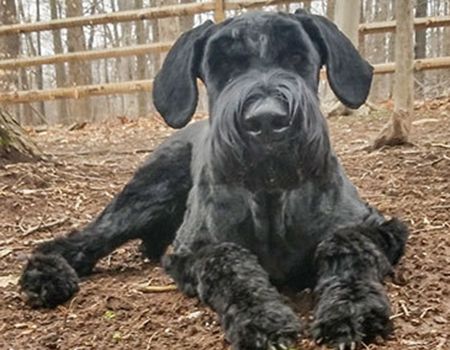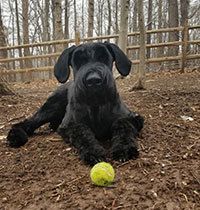Bad behavior? The pet may be in pain
Medical etiologies, including pain, must always be considered as differential diagnoses for behavior problems with veterinary patients, especially with a sudden change or exacerbation of a previously stable behavior. Heres what to watch out for as well as three cases where pain was the culprit.
Dr. Amy Pike is not immune to dealing with behavior problems. All of a sudden, her 2-year-old giant schnauzer, Ike, started food-guarding around his housemates. Find out what was happening below and on the next page. (Photos courtesy of Dr. Pike.)

Medical etiologies, including pain, must always be considered as differential diagnoses for behavior problems, especially with a sudden change or exacerbation of a previously stable behavior. Unfortunately, pain can be difficult to assess clinically in a hospital setting, especially when the patient is experiencing fear, anxiety or stress. Our scared patients will make every attempt to suppress signs of vulnerability, including pain, leaving clinicians potentially shrugging their shoulders and assuming the patient is “fine.”
In my practice as a behaviorist, pain has definitely been underdiagnosed and underestimated as being clinically relevant, even by specialists trained to evaluate lameness. So if diagnosing pain is difficult at best, how does a clinician determine whether pain is a differential diagnosis when presented with a behavioral disorder?
First steps: Ask questions, ask for video, run tests
There are several veterinary client questionnaires available (like the PennVet Canine Brief Pain Inventory or the Canine Acute Pain Scale from Colorado State University). Any change noted by pet owners should be considered clinically significant enough to contribute to a behavior problem. In addition to client questions, one of my favorite methods of diagnosing pain is to have the owner take video of the pet and evaluate that in conjunction with the physical exam. Ask owners to take videos of the pet going up and down stairs, jumping onto and off of furniture, getting up after resting, ambulating after vigorous exercise and getting into and out of vehicles. You'll also see whether the pet refuses to do any of the above activities.
If there's any stiffness, delay or hesitation to movements, or evidence of limping seen, pain should be considered as a contributing factor. In addition to video and client questionnaires, a physical exam including orthopedic and neurologic examinations should be performed. Additional diagnostics for a sudden change or exacerbation of a previously stable behavior problem include a complete blood count, a serum biochemical profile, urinalysis, total T4 and free T4 by equilibrium dialysis. Additional tests may be warranted, including additional endocrine screening and imaging modalities.
Elimination, grooming and aggression
Behavior changes associated with pain may appear seemingly unrelated to the untrained eye. In cats, common behavior changes associated with pain are elimination outside of the litterbox, changes in appropriate grooming behavior, aggression and sudden onset of any new behavior or exacerbation of a previously stable behavior. In dogs, we can see house soiling, aggression and the sudden onset of a new behavior or exacerbation of a previously stable behavior as well.
Cats: Looking at litterboxes. A litterbox can become inaccessible to a cat experiencing pain. This can be because the box is located up- or downstairs from the cat's preferred part of the home. It could be because the box is located behind a baby gate or other barrier. A litterbox designed to keep other pets out or one with moderately high sides can prevent access to painful cats. Even in homes with multiple boxes, another cat in the household may block access to the nearest box (whether intentionally or unintentionally), and a painful cat may choose an alternate location rather than walking to another box. A dog may also make it difficult for a cat to quickly and safely get to the litterbox.
Dogs: Home hassles that lead to house soiling. Dogs will house soil as a result of pain for similar reasons as cats. If access to the outdoors is down a set of stairs, the dog may choose to soil indoors. A painful dog in a multidog household may hang back inside to avoid being jostled while other dogs race to the door to be let out. If city dogs on a leash are painful and don't want to walk far, they may not be outside long enough to eliminate before they start limping and need to go back inside to rest.
Cats: Signs of pain in grooming. Feline patients are fastidious creatures, spending a significant portion of their day grooming. Cats experiencing pain, however, especially in their spine, may not want to bend around to groom harder-to-reach areas. Fur may take on a dull appearance in ungroomed areas, and mats may develop on long-haired cats. Alternatively, if a cat is painful in a particular location, it may begin to groom that area either more often or more vigorously than normal as an attempt to soothe the pain. This can potentially lead to hair loss.
Dogs and cats: An eye on aggression. Dogs and cats experiencing pain will be more irritable in general, which leaves them much more likely to act aggressively when triggered. Aggression can be seen when people pet them, especially when they're resting comfortably. Another common scenario happens when another animal tries to play with the painful pet, which relies on aggressive strategies to stop the interaction. Even something as common as leash reactivity (aggression toward unfamiliar dogs when on leash) can be worsened by pain, because the dog is more likely to be aggressive to keep other dogs away. Aggression during veterinary visits can be a key indicator that pain should be high on the differential list.
Dr. Pike's dog Ike

Case studies: When behavior change is a medical issue
Behavior in and of itself doesn't just change overnight unless there's a traumatic event. In the absence of such an event, when pet owners show up with a new behavior change, medical etiologies are likely at play. The same is true for a previously stable behavior problem. To highlight my point, let's look at three cases:
Well-managed behavioral patient starts guarding food again. Ike is my own 2-year-old male neutered giant schnauzer with a history of chronic otitis externa. While Ike has numerous behavioral issues, including conflict aggression, resource guarding and fear-based aggression toward unfamiliar people, he is stable on a combination of modification, medication and management. Ike lives with two other dogs he gets along with amazingly well-a 12-year-old female spayed Scottish terrier and a 1-year-old male, neutered mini schnauzer. However, when Ike is experiencing pain from a recurrence in his otitis, he once again starts to guard food from his housemates. He can't be in the kitchen or the dining room without becoming aggressive toward the other dogs and chasing them out, even if food isn't being doled out from the humans. Treat the otitis, and the resource guarding goes away.
Behavioral patient shows separation anxiety with a vengeance. Potato is a 6-year-old female spayed pug with a history of separation anxiety. Potato was treated with desensitization to progressively longer departures until the pug could be left home alone for a typical workday. Fast-forward eight months and Potato suddenly reverted back to overt panic when left home alone: She destroyed the couch, the carpet and the doorframe in the first hour of her owner's going to work. Potato's trainer called me, and I recommended she be seen by her primary care veterinarian to rule out a medical cause for this sudden change. Upon exam, Potato's veterinarian discovered a red, swollen, infected interdigital cyst. After treatment, Potato was once again able to be left alone for an entire workday without other intervention.
Friendly dog starts to lunge on the leash. “Colonel” is a 5-year-old male neutered American Staffordshire terrier missing one of his hindlimbs due to an injury and subsequent amputation prior to adoption. Colonel is a model ambassador for the breed and loved all other dogs and humans until two years prior to visiting my practice, when he started becoming reactive toward unfamiliar dogs. The first incident occurred at a local event, when he lunged and barked at two huskies walking toward him. The owner thought the behavior was strange but shrugged it off as just something about those particular dogs. However, the owner soon became more concerned, as the behavior quickly escalated to include any dogs Colonel encountered when on leash.
Upon physical observation of Colonel, it was obvious he was stiff and slow upon rising from resting and was so painful in his remaining hindlimb when ambulating that he was significantly wearing down his toenails. We treated Colonel with a combination of an NSAID, an alpha-2-delta ligand, cold laser therapy and twice-weekly water treadmill rehabilitation for the next several months. Next time Colonel returned to that same event, he was once again the perfect model citizen with good pain control on board.
As veterinarians, we need to always do our due diligence and rule out medical etiologies when presented with behavior changes. Pain should always be considered a differential diagnosis for behavior problems, even if pain and the behavior seem completely unrelated.
Dr. Pike graduated from Colorado State University in 2003 and was commissioned as a captain in the U.S. Army Veterinary Corps. She is chief of the Behavior Medicine Division at the Veterinary Referral Center of Northern Virginia in Manassas, Virginia, and a member of the Fear Free Advisory Committee.